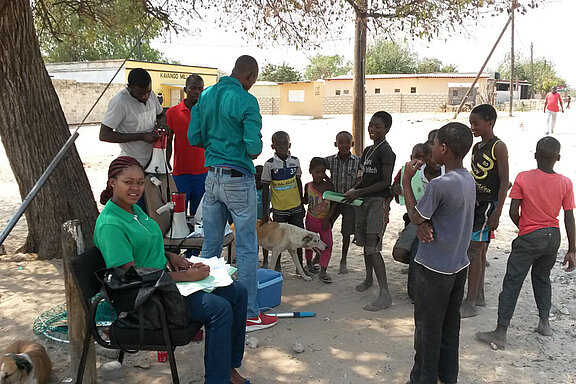Greifswald - Insel Riems, 28 Sept. 2017. September 28 is World Rabies Day, an international campaign coordinated by the Global Alliance for Rabies Control (GARC) and supported by the World Health Organization (WHO), the World Organisation for Animal Health (OIE), and the Food and Agriculture Organization of the United Nations (FAO). Aims of the World Rabies Day are to raise awareness for this fatal human and animal disease, to provide information and to explain how to prevent disease in risk areas. Still 70,000 humans worldwide die from rabies each year. The FLI in parthnership with OIE is supporting Namibia in implementing a rabies control project in Namibia.
Namibia is about twice the size of Germany and has more than two million inhabitants. Rabies represents an enormous public health and economic problem. Livestock farming is one of the most important sources of income and is highly regarded in the Namibian society. In addition to cattle and sheep farming, farming of kudu, an African antelope species, is an important economic branch. Since the 1970s rabies in kudu is a massive problem for agriculture in Namibia. On the one hand vaccination is difficult to carry out, on the other hand the ecological background of kudu rabies is largely unknown. The by far bigger problem however is dog rabies, particularly in the Northern part of the country. In this part of the country, dog rabies is the main cause of human rabies infections. Namibia strives to control dog rabies. However, the number of dogs to be immunized is very high as are the expenditures for personnel carrying out the vaccinations and the costs for establishing the required infrastructure.
The dog rabies control project directed by the OIE is carried out in cooperation with the Namibian Ministry of Agriculture, Water and Forestry and receives 300,000 € of funding from the German Federal Ministry of Food and Agriculture (BMEL). “Rabies control is feasible provided key elements in organizing a mass dog vaccination campaign are well considered and executed in advance. These elements are legal framework, leadership, training, public and stakeholder commitment, logistic and planning.” says Dr. Rauna Athingo, leader of the dog rabies elimination program in Namibia. Therefore, this is a sensible support measure, as the vaccination campaigns have helped reduce the number of dog rabies cases in the Oshana region significantly for the first time. ”The fight has been intensified. (…) We vaccinated a lot of dogs. More than two times of the number we have been vaccinating every year before. People now have increased attention and report much more cases of dog rabies. That is a success of the campaign.”, says Dr. Emmanuel Hikufe, head of the Epidemiology subdivision of the Directorate of Veterinary Services of the Namibian Ministry of Agriculture, Water and Forestry (MAWF). Dr. Athingo adds: “What we have learned is that timing the vaccination campaigns is very crucial. Conducting campaigns during school holiday has helped to vaccinate more dogs since school children play a very crucial role by bringing their dogs to the vaccination point.”
The FLI does not only help by providing expertise – classical terrestrial rabies has been combatted successfully in Germany – but also by assisting in analyzing the rabies situation in the entire country, in rabies diagnostics and in understanding the ecological background of the spread of the disease in the region. Dr. Thomas Müller, head of the German National Reference Laboratory and of the international OIE Reference Laboratory for Rabies says about the project: ”The major aim is to help the Namibian colleagues to solve the problem themselves. We provide the knowhow and the technical support.” The FLI also houses a WHO “Collaborating Centre for Rabies Surveillance and Research". Dr. Hikufe: ”The collaboration of the FLI with other countries in the monitoring and control of rabies is exemplary.”
A decisive next step will be to extend the dog vaccination campaign to the neighboring regions and to monitor the progress of disease control. Furthermore, joint efforts will be made to find possibilities for oral vaccination of stray dogs with the aim to increase vaccination coverage in the dog population. To achieve long-term success, inclusion of the neighboring countries Angola, Zambia, and Botswana and a lasting international partnership are essential.
Contact:
Dr. Thomas Müller
Tel: +49 38351 7-1659
Mail: thomas.mueller@~@fli.de


